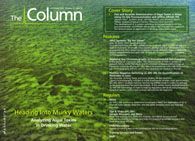Capillary Electrophoresis Applied to Cystic Fibrosis Diagnosis
Scientists from CEITEC Masaryk University are collaborating with clinicians from the Department of Respiratory Diseases and TB at the University Hospital Brno (Brno, Czech Republic) to improve the diagnosis of cystic fibrosis, specifically in newborn babies. In a new study published in the Journal of Chromatography A, a new "skin wipe" sweat sampling method is presented that reduces the time required for sampling to under a minute and utilizes capillary electrophoresis (CE) to simultaneously determine chloride, sodium, and potassium ions in sweat samples.
Photo Credit: Compassionate Eye Foundation/Three Images/Getty Images

Scientists from CEITEC Masaryk University are collaborating with clinicians from the Department of Respiratory Diseases and TB at the University Hospital Brno (Brno, Czech Republic) to improve the diagnosis of cystic fibrosis, specifically in newborn babies. In a new study published in the Journal of Chromatography A, a new “skin wipe” sweat sampling method is presented that reduces the time required for sampling to under a minute and uses capillary electrophoresis (CE)to simultaneously determine chloride, sodium, and potassium ions in sweat samples.1
Cystic fibrosis (CF) is a rare genetic disorder resulting from a mutation in a transmembrane conductance regulator (CFTR) gene that causes defective ion transfer across epithelial cellular membranes, causing the formation of thicker and stickier mucus. This is a problem for those affected because it impacts multiple organs, particularly the lungs, and can result in repeated lung infections. According to the paper, there are screening programmes worldwide to detect the disorder in newborn babies because studies have shown early diagnosis can improve patient outlook.
The quickest screening method for the disorder is the “sweat test”; results of the test are subsequently confirmed by genetic testing. During the sweat test a chemical to cause sweating is applied to a small area on the arm or leg, and an electrode is then applied over the same area. A weak electrical current is applied to the area and then the sweat is collected, using, for example, filter paper or gauze. The sweat is then analyzed to determine the levels of chloride ions; elevated chloride ion levels indicate a positive result.
Corresponding author Petr Kuban told The Column: “We realized that the 30-min sampling using pilocarpine iontophoresis and sweat induction might not be the most comfortable for the very small babies. Additionally the analysis of chloride alone gives many false positive/negative results. Chloride levels also change with age and the border values for CF diagnosis are not clearly defined.” He added: “We thought that since we have the analytical technique (capillary electrophoresis coupled with contactless conductivity detection [CE-C4D]) able to analyze many ions simultaneously, it would be interesting to see if there are other correlations among the ions that could be used for more reliable screening.”
Cotton swabs soaked in water were wiped against the skin of 10 patients and 10 healthy participants three times and were then extracted in deionized water for 15 min. The extracts were then analyzed by double opposite end injection capillary electrophoresis with contactless conductomeric detection to determine chloride, sodium, and potassium ions. Kuban said: “We were analyzing breath samples of CF patients in another study and as a part of this study, we decided to take some alternative samples, such as skin wipe and saliva. We knew that we can analyze the selected ions simply by our CE-C4D instrument and by careful studying [of] the resulting electropherograms, we noticed the differences in the ion ratios of healthy volunteers and CF patients. These differences repeated rather consistently in all samples.”
A key drawback of the current “sweat test” is the frequency of false positive and false negative results when relying on the determination of chloride ions. The new method reduced this by using ion concentration ratios rather than chloride ion concentration, as well as saving time during samplecollection, according to Kuban. He said: “Last but not least is also significant decrease in the cost of sampling using our developed method (skin wipe) compared to pilocarpine iontophoresis.” According to the paper, to use the method in clinical practice requires further study, which is currently underway. — B.D.
Reference
1. P. Kubán et al., Journal of Chromatography A 1358, 293–298 (2014).
This story originally appeared in The Column. Click here to view that issue.


.png&w=3840&q=75)

.png&w=3840&q=75)



.png&w=3840&q=75)



.png&w=3840&q=75)











